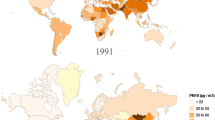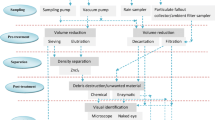Abstract
During the 2013 Arctic campaign, direct measurements and size-segregated samplings of atmospheric aerosol were carried out from March to September at the Gruvebadet observatory in Ny-Ålesund (78°56′N, 11°56′E; Svalbard Islands). Continuous size distribution measurements (104 size classes) were performed both in the nano- (TSI-SMPS system) and micro-metric (TSI-APS device) range with a resolution of 10 min. Aerosol sampling was carried out on daily basis (PM10 fraction, 00:01–23:59 UTC) and with a 4-day resolution (four-stage cascade impactor). A back-trajectory analysis was performed for specific events to understand transport processes and possible source areas of aerosol reaching Ny-Ålesund. Aerosol samples were analyzed for ion composition (inorganic cations and anions, selected organic anions) by a three-chromatograph system after extraction in ultra-sonic bath. Special attention was spent in identifying and interpreting the seasonal pattern of natural and anthropic chemical markers. Sea spray aerosol was evenly distributed along all the sampling period with maxima related to wind speed. Its size distribution peaks in 1.0–2.5 or 2.5–10 µm, depending on the transport conditions and distance from source areas. Anthropic sulfate dominates the spring aerosol load (Arctic Haze), both in acidic form (H2SO4) and in partially or totally neutralized ammonium salts. Biogenic contributions, marked by methanesulfonic acid, are relatively relevant in late spring–early summer and are distributed in the finest aerosol fraction (<1.0 µm).







Similar content being viewed by others
References
Albrecht BA (1989) Aerosols, cloud microphysics and fractional cloudiness. Science 245:1227–1230
Bates TS, Calhoun JA, Quinn PK (1992) Variations in the methane-sulfonate to sulfate molar ratio in submicrometer marine aerosol particles over the South Pacific Ocean. J Geophys Res 97:9859–9865
Bazzano A, Ardini F, Grotti M, Malandrino M et al (2016) Elemental and lead isotopic composition of atmospheric particulate measured in the Arctic region (Ny-Ålesund, Svalbard Islands). Rend Fis Acc Lincei (this issue)
Becagli S, Scarchilli C, Traversi R, Dayan U, Severi M, Frosini D, Vitale V, Mazzola M, Lupi A, Nava S, Udisti R (2012) Study of present-day sources and transport processes affecting oxidised sulphur compounds in atmospheric aerosols at Dome C (Antarctica) from year-round sampling campaigns. Atmos Environ 52:98–108
Becagli S, Lazzara L, Marchese C, Dayan U, Ascanius SE, Cacciani M, Caiazzo L, Di Biagio C, Di Iorio T, Di Sarra A, Eriksen P, Fani F, Giardi F, Meloni D, Muscari G, Pace G, Severi M, Traversi R, Udisti R (2016) Relationships linking primary production, sea ice melting, and biogenic aerosol in the Arctic. Submitted to Atmospheric Environment
Bowen HJM (1979) Environmental Chemistry of the Elements. Academic Press
Dal Maso M, Kulmala M, Riipinen I, Wagner R, Hussein T, Aalto PP, Lehtinen KEJ (2005) Formation and growth of fresh atmospheric aerosols: eight years of aerosol size distribution data from SMEAR II. Boreal Environ Res 10:323–336
Das R, Das SN, Misra VN (2005) Chemical composition of rainwater and dustfall at Bhubaneswar in the east coast of India. Atmos Environ 39:5908–5916
Engvall AC, Krejci R, Ström J, Treffeisen R, Scheele R, Hermansen O, Paatero J (2007) Changes in aerosol properties during spring-summer period in the Arctic troposphere. Atmos Chem Phys Discuss 7:1215–1260
Fisher JA, Jacob DJ, Wang Q, Bahreini R, Carouge CC, Cubison MJ, Dibb JE, Diehl T, Jimenez JL, Leibensperger EM, Lu Z, Meinders MBJ, Havala Pye OT, Quinn PK, Sharma S, Streets DG, van Donkelaar A, Yantosca RM (2011) Sources, distribution, and acidity of sulfate-ammonium aerosol in the Arctic in winter-spring. Atmos Environ 45:7301–7318
Gondwe M, Krol M, Gieskes W, Klaassen W, de Baar H (2003) The contribution of ocean-leaving DMS to the global atmospheric burdens of DMS, MSA, SO2, and NSS SO4 2−. Global Biogeochemical Cycles 17(2):1056
Gondwe M, Krol M, Klaassen W, Gieskes W, de Baar H (2004) Comparison of modeled versus measured MSA:nss SO4 2− ratios: a global analysis. Global Biogeochemical Cycles 18, GB2006
Heintzenberg J, Hansson HC, Lannefors H (1981) The chemical composition of arctic haze at Ny-Alesund, Spitsbergen. Tellus 33:162–171
Henderson P, Henderson GM (2009) The Cambridge handbook of earth science data. Cambridge University Press
IPCC 2014, Kirtman B, Power SB, Adedoyin JA, Boer GJ, Bojariu R, Camilloni I, Doblas-Reyes FJ, Fiore AM, Kimoto M, Meehl GA, Prather M, Sarr A, Schär C, Sutton, R, van Oldenborgh GJ, Vecchi G, Wang HJ (2013) Near-term Climate Change: Projections and Predictability. In: Climate Change 2013: The Physical Science Basis. Contribution of Working Group I to the Fifth Assessment Report of the Intergovernmental Panel on Climate Change. Cambridge University Press, Cambridge, United Kingdom and New York, NY, USA
Iversen T, Joranger E (1985) Arctic air-pollution and large scale atmospheric flows. Atmos Environ 19:2099–2108
Kulshrestha UC, Sarkar AK, Srivastava SS, Parashar DC (1996) Investigation into atmospheric deposition through precipitation studies at New Delhi (India). Atmos Environ 30:4149–4154
Leck C, Persson C (1996) Seasonal and shot-term variability in dimethyl sulfide, sulfur dioxide and biogenic sulfur and sea salt aerosol particles in the arctic marine boundary layer during summer and autumn. Tellus 48B:272–299
Lundén J, Svensson G, Leck C (2007) Influence of meteorological processes on the spatial and temporal variability of atmospheric dimethyl sulfide in the high Arctic summer. J Geophys Res 112:D13308
Pincus R, Baker M (1994) Precipitation, solar absorption, and albedo susceptibility in marine boundary layer clouds. Nature 372:250–252
Quinn PK, Shaw G, Andrews E, Dutton EG, Ruoho-Airola T, Gong SL (2007) Arctic haze: current trends and knowledge gaps. Tellus 59:99–114
Robock A (1983) Ice and snow feedbacks and the latitudinal and seasonal distribution of climate sensitivity. J Atmos Sci 40:986–997
Röthlisberger R, Mulvaney R, Wolff EW, Hutterli MA, Bigler M, Sommer S, Jouzel J (2002) Dust and sea salt variability in central East Antarctica (Dome C) over the last 45 kyrs and its implications for southern high-latitude climate. Geophys Res Lett 29:1963
Saltzman ES (1995) Ocean/atmosphere cycling of dimethylsulfide. In: Delmas RJ, ed. Ice-core Studies of Global Biogeochemical Cycle. Berlin, etc., Springer-Verlag, 65-89. (NATO ASI Series I: Global Environmental Change, 30)
Screen JA, Simmonds I (2010) The central role of diminishing sea ice in recent Arctic temperature amplification. Nature 464:1334–1337
Sharma S, Chan E, Ishizawa M, Toom-Sauntry D, Gong SL, Li SM, Tarasick DW, Leaitch WR, Norman A, Quinn PK, Bates TS, Levasseur M, Barrie LA, Maenhaut W (2012) Influence of transport and ocean ice extent on biogenic aerosol sulfur in the Arctic atmosphere. J Geophys Res 117:D12209
Shaw GE (1984) Microparticle size spectrum of Arctic haze. Geophys Res Lett 11:409–412
Stein AF, Draxler RR, Rolph GD, Stunder BJB, Cohen MD, Ngan F (2015) NOAA’s HYSPLIT atmospheric transport and dispersion modeling system. Bull Am Meteorol Soc 96:2059–2077
Ström J, Umegård J, Tørseth K, Tunved P, Hansson HC, Holmén K, König-Langlo G (2003) One year of particle size distribution and aerosol chemical composition measurements at the Zeppelin Station, Svalbard, March 2000-March 2001. Phys Chem Earth 28:1181–1190
Tunved P, Ström J, Krejci R (2013) Arctic aerosol life cycle: linking aerosol size distributions observed between 2000 and 2010 with air mass transport and precipitation at Zeppelin station, Ny-Ålesund, Svalbard. Atmos Chem Phys 13:3643–3660
Udisti R, Dayan U, Becagli S, Busetto M, Frosini D, Legrand M, Lucarelli F, Preunkert S, Severi M, Traversi R, Vitale V (2012) Sea spray aerosol in central Antarctica. Present atmospheric behaviour and implications for paleoclimatic reconstructions. Atmos Environ 52:109–120
Udisti R, Bazzano A, Becagli S, Bolzacchini E et al (2016) Sulfate source apportionment in the Ny-Ålesund (Svalbard Islands) Arctic aerosol. Rend Fis Acc Lincei (this issue)
Acknowledgements
This peer-reviewed article is a result of the multi and interdisciplinary research activities based at the Arctic Station “Dirigibile Italia”, coordinated by the “Dipartimento Scienze del Sistema Terra e Tecnologie per l’Ambiente” of the National Council of Research. This study was partially funded by the Italian Ministry of University and Research (MIUR) within the framework of the PRIN-2007 (“Dirigibile Italia”) and PRIN-2009 (“Arctica”) projects. The logistic assistance of the Polar Support Unit of the CNR Department of Earth and Environment (POLARNET) is gratefully acknowledged. This work was also partially supported by Italian MAE (Ministry of Foreign Affairs), within a bilateral cooperation program, in the framework of the Italy-South Korea agreement 2013-2015. The authors gratefully acknowledge the NOAA Air Resources Laboratory (ARL) for the provision of the HYSPLIT transport and dispersion model used in this publication.
Author information
Authors and Affiliations
Corresponding author
Additional information
This peer-reviewed article is a result of the multi and interdisciplinary research activities based at the Arctic Station "Dirigibile Italia", coordinated by the "Dipartimento Scienze del Sistema Terra e Tecnologie per l'Ambiente" of the National Research Council of Italy.
Rights and permissions
About this article
Cite this article
Giardi, F., Becagli, S., Traversi, R. et al. Size distribution and ion composition of aerosol collected at Ny-Ålesund in the spring–summer field campaign 2013. Rend. Fis. Acc. Lincei 27 (Suppl 1), 47–58 (2016). https://doi.org/10.1007/s12210-016-0529-3
Received:
Accepted:
Published:
Issue Date:
DOI: https://doi.org/10.1007/s12210-016-0529-3




